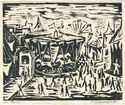
19th, 20th & 21st Century Fine Prints
707-546-7352 · fax 707-546-7924 · web: www.annexgalleries.com · email: artannex@aol.com
Fred Rappaport Biography
Fred Rappaport
American
1912–1989
Biography
Born in Vienna, Austria in 1912, he was a well known painter and printmaker.
Rappaport began painting in his teens at Vienna’s Lower Gymnasium after having found an art teacher who supported his work and mentored him to really allow his talent to evolve. He had an all-consuming desire to become an artist, unfortunately his parents disapproved of his career choice, preferring medicine. Fortunately for him, his aunt and uncle who were prominent Austrian antique dealers swayed his parents, and they let him enter the Akademie der Bildenden Kunste (1931-1935). After graduating from school, Fred worked as an art and dress designer and window trimmer for Herzmanski, a large Viennese department store. He married his wife, Tilda, shortly after finding work. However, family pressure to become something more than an artist constantly plagued him, and finally in 1935, he entered medical school, feeling guilty for his desire to be an artist at the expense of earning a better living for his family.
His medical education was cut short by war with Germany. After the Nazi occupation of Austria in 1938, life as a Jew became unbearable, and he was fortunate enough to immigrate with his wife to the United States, where he settled in Chicago.
Once in Chicago, and away from familial pressure, he again concentrated on the arts. He attended the Chicago Academy of Fine Arts (1942-1943) and the University of Illinois. After graduating, he ventured into the fledgling, novel practice of art therapy (Chicago State Hospital and Veterans Administration Hospital). He was responsible for several major innovations in psychiatric art therapy, including the staging of art fairs for institutionalized mental patients. He utilized a variety of art media to stimulate and accelerate the cerebral and manual activity of his patients. He authored an article entitled “Window on the Unconscious Drawings of Patients” which was published in the 1982 Medical and Health Annual, Encyclopedia Britannica. He also wrote a novel, Good Bye Vienna. He taught art at the Chicago Jewish Community Center, Suburban Fine Arts Center in Highland Park, and Studio 514 on Fullerton Parkway, Chicago.
He was multitalented, and opened on an optometry practice, with studio facilities in the rear (335 West Belden Ave, Chicago, IL 60614), so that once he had closed the medical practice for the day, he could venture back into his studio and create. He was also a fantastic print maker, using the wood cut and reduction plate creation methods to make prints that were interestingly three dimensional. It is well acknowledged that few artists could match his draftsmanship and aesthetic refinement.
He once said: “Any artistic creation presumes an inherent need to express an emotional reaction to a single or to a series of communicated experiences. Thus, the work of art is based upon the interaction of the artist and his environment and represents a more or less high form of communication.”
He made many trips to Israel after its creation in 1947, infatuated with the idea of a Jewish homeland. He painted many scenes of the countryside and the ancient city of Jerusalem.
In the 1950’s and 1960’s, he began painting colorful abstract works, moving away from impressionism and more customary representations of landscapes. These works evidence his evolution as an artist into his more mature style.
Rappaport died in Chicago in 1989, after contributing greatly to the Chicago art scene.
Information provided by Lisette Ruch


